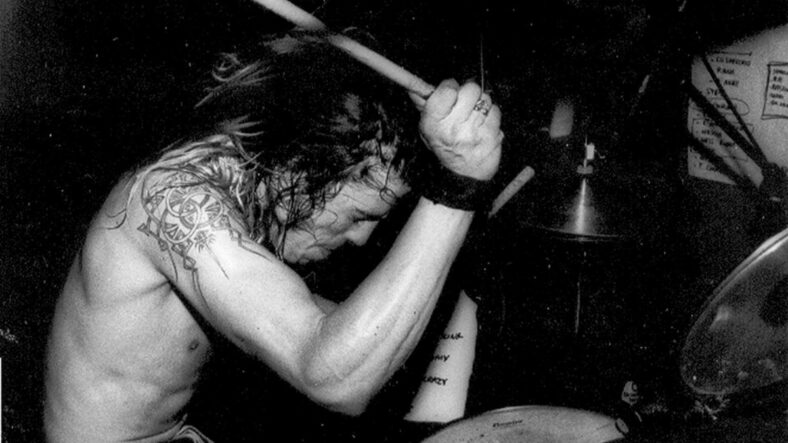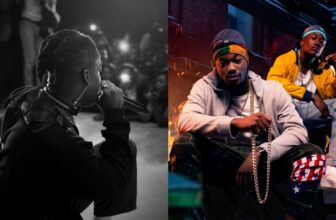What is Grunge Music? (With Examples)

Grunge music is a subgenre of alternative rock characterized by its raw sound and introspective lyrics, often associated with bands such as Nirvana, Pearl Jam, and Soundgarden. This musical style emerged from Seattle, Washington, in the late 80s and reached widespread popularity in the early 90s.
Grunge music’s distinctive characteristics include a fusion of punk rock and heavy metal elements, with guitar distortion, heavy drumming, and raspy vocals. Its roots can be traced back to influences from punk rock, alternative, and indie rock bands of the 1970s and 80s.
Grunge music had a profound cultural impact, giving voice to the frustrations and anxieties of a generation while also influencing fashion trends with a casual and unkempt style. Today, grunge music’s legacy can be seen in various revivals and new bands that have adopted its raw sound and defiant attitude.
Contents
Grunge Music Characteristics
Grunge music characteristics primarily revolve around its distinctive and powerful musical elements. This genre emerged as a unique blend of style, setting it apart from other music styles of the time. Some of the defining features of grunge include:
- Guitar-driven sound: Grunge music is known for its focus on murky-guitar bands, where heavily distorted guitars and dark, moody chords create a distinct alternative rock atmosphere.
- Raw vocals: The vocals in grunge music range from raspy and guttural to melodic and accessible, often imbuing the songs with raw emotion and power.
- Incorporation of various influences: Grunge combines elements from heavy metal, post-punk, and other alternative rock subgenres, which contributes to its distinct sound and character.
These characteristics of grunge music enable the genre to stand out as a prominent musical style, capturing the hearts and ears of its listeners with a unique fusion of musical elements.
The Roots and Influences of Grunge
The roots and influences of grunge music can be traced back to the Seattle music scene of the 1980s. This vibrant and creative environment played a significant role in shaping the unique sound associated with grunge. A few key aspects contributed to the development of grunge music:
- Seattle’s vibrant music scene: During the 1980s, Seattle was thriving with various bands and musicians experimenting with different musical styles. This atmosphere allowed grunge bands to emerge and develop their distinct sound, mixing punk ethos with the aggression of heavy metal.
- Connection to punk and heavy metal: Grunge drew inspirations from both punk and heavy metal, blending the raw energy of punk with the heaviness of metal. This fusion resulted in the creation of a genre that rebelled against mainstream music, much like punk.
- Factors contributing to its rise in popularity: Along with the unique sound and passionate performances, the growing dissatisfaction with the commercial music scene in the late 1980s and early 1990s helped propel grunge into mainstream consciousness.
Pioneering Grunge Musicians
The grunge movement was led by a handful of pioneering bands that brought the distinct sound and style to the forefront of the music industry. These trailblazing musicians made significant contributions to the genre with their unique approaches and musical influences. Some of the most notable grunge bands include:
- Nirvana: Fronted by the late Kurt Cobain, Nirvana is often considered the band that brought grunge to the masses. Known for their raw sound and introspective lyrics, they produced iconic songs like “Smells Like Teen Spirit” and “Come As You Are.”
- Pearl Jam: With their mix of classic rock and punk influences, Pearl Jam achieved great success in the 90s with songs like “Alive” and “Even Flow.” Their powerful live performances helped cement their status as a premier grunge band.
- Smashing Pumpkins: While not as closely linked to the Seattle scene, this Chicago-based band also contributed significantly to the grunge era. Their unique blend of alternative rock, gothic, and art rock influences resulted in hits such as “Bullet with Butterfly Wings” and “1979.”
- Soundgarden: Spearheaded by the powerful voice of Chris Cornell, Soundgarden’s heavy sound and introspective themes embodied the spirit of grunge. Their songs like “Black Hole Sun” and “Spoonman” became anthems of the movement.
- Alice in Chains: With their dark, angst-filled lyrics and heavily distorted guitars, Alice in Chains carved out their own space within the grunge landscape. Their songs such as “Would?” and “Rooster” have become classics in the genre.
These pioneering grunge musicians laid the foundation for the genre, shaping its identity and influencing countless bands that followed in their footsteps. Other notable mentions include Mudhoney, Melvins, Malfunkshun, Skin Yard, and Green River.
Iconic Grunge Songs
Some iconic grunge songs have become well-known not only for their popularity but also for their ability to embody the spirit and characteristics of the genre. These songs capture the essence of grunge music, showcasing the raw energy, introspective lyrics, and unique musical blends that define the movement. A few of these iconic songs include:
- “Smells Like Teen Spirit” by Nirvana: The song that catapulted Nirvana and grunge into the mainstream, this track encapsulates the rebellious spirit and raw sound synonymous with grunge music.
- “Alive” by Pearl Jam: With its powerful guitar riffs and anthemic chorus, “Alive” remains a staple in Pearl Jam’s repertoire and showcases their unique blend of punk and classic rock influences.
- “Superunknown” by Soundgarden: This song exemplifies Soundgarden’s heavy sound, intricate arrangements, and Chris Cornell’s dynamic vocals, which notably contribute to the fabric of grunge music.
- “Man in the Box” by Alice in Chains: Another hallmark grunge track, this song displays the dark, moody tones and anguished lyrics that have made Alice in Chains stand out in the genre.
- “Come as You Are” by Nirvana: This introspective and melodic track reflects the more contemplative side of grunge music, demonstrating the versatility of the genre’s musical expression.
These classic songs represent the grunge movement’s quintessential sound, and they continue to influence and inspire musicians and fans today.
Grunge Music and its Cultural Impact
Grunge music had a significant cultural impact that extended beyond the confines of the music industry, influencing various aspects of daily life, subculture, and art. The movement embodied themes of alienation and angst, which resonated with many during the period. Grunge’s most prominent influences include:
- Fashion: Grunge inspired a laid-back and casual fashion sense, characterized by flannel shirts, ripped jeans, and worn-out sneakers. This “anti-fashion” movement served as a rejection of the polished and glamorous styles of the 1980s, reflecting the same rebellious spirit found in the music.
- Graphic design: Grunge aesthetics permeated art and graphic design, leading to a gritty and unpolished visual language. Album covers, concert posters, and other visual elements adopted this raw look, representing the imperfections and authenticity associated with the genre.
- Connection to themes of alienation and angst: The grunge subculture provided a sense of identity and belonging to those who felt disconnected from mainstream culture. Its introspective and emotional themes resonated with a generation searching for meaning and authenticity amid a world of consumerism and artificiality.
The cultural impact of grunge music highlights its significance not just as a musical style, but also as a reflection of the era’s attitudes, values, and social concerns. Grunge’s legacy continues to influence fashion, music, and art today, serving as a testament to the movement’s enduring relevance.
Legacy and Revivals of Grunge Music
Grunge music’s legacy has continued to make an impact on subsequent genres and subcultures, demonstrating its lasting influence on the music industry. The genre has experienced numerous revivals and has inspired various other musical movements. Notable effects of grunge music’s legacy include:
- Post-grunge: This subgenre emerged in the wake of grunge’s popularity, with bands like Foo Fighters and Creed adopting a more polished sound while maintaining the introspective themes and alternative rock influences of the original movement.
- Britpop: Grunge music indirectly influenced the rise of Britpop, a UK-based music genre of the mid-1990s. Britpop was fueled by a desire to create a distinct British identity that countered the domination of American grunge and other alternative rock styles.
- Fusion genres: Grunge has left a lasting impression on many other fusion genres, blending its elements with various music styles. Bands like Radiohead and Muse have incorporated grunge influences in their work, creating a diverse range of sounds that continue to echo the spirit of the original movement.
- Contemporary revivals: Recent years have witnessed a resurgence of grunge-inspired bands and musicians, such as Wolf Alice and Greta Van Fleet, who carry on the legacy of the genre by incorporating its characteristic raw sound and emotional depth.
Conclusion
In conclusion, grunge music emerged in the late 1980s as a rebellious and powerful genre that resonated with a generation seeking authenticity and expression of their frustrations. Defined by its unique blend of punk, heavy metal, and alternative rock influences, grunge gave rise to iconic bands like Nirvana, Pearl Jam, and Soundgarden. Their introspective lyrics and signature guitar-driven sound not only shaped the music but also led to a significant cultural impact on fashion, art, and subcultures.
The legacy of grunge music remains influential, inspiring contemporary bands and influencing fusion genres worldwide. Grunge will forever be a testament to the power of raw emotion, authenticity, and musical innovation in shaping an entire generation’s identity and cultural landscape.
Dave Grohl Featured Image by: Tobby Holzinger / Agentur Spirit, CC BY-SA 3.0, via Wikimedia Commons





